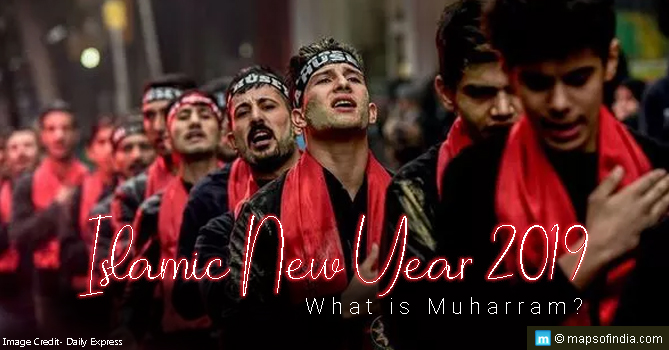
The Historic Hijri
Muharram is the first month of the lunar Hijri Calendar, followed by Muslims the world over. The Islamic Calendar, used by many Muslim nations of the world, is used to ascertain most Islamic religious observances including the Ramadan fasting, Hajj pilgrimage and other festivals. The calendar starts with Prophet Muhammad’s emigration from Mecca to Medina (called Yathrib at the time, in 622 AD according to the Gregorian calendar). The calendar that started with this historic journey came to be called Hijrah or Hijri, meaning ‘migration’ in Arabic. The years of the Hijri calendar are represented by the letters AH. The new Islamic year will tentatively start from September 10, 2019 is thus designated Muharram Safar 1441 AH.
The First Month
The month of Muharram is ushered in by the sighting of the new moon. It is one of the four sacred months according to the Holy Quran. Prophet Muhammad is himself believed to have declared, “One year consists of twelve months, of which four are sanctified months… Zulqadah, Zulhijjah, Muharram, and the fourth is Rajab.” Historians believe that the Arabs also considered these months sacred (before the introduction of Islam) and abstained from warlike activities in these months. The word Muharram may be translated to mean “forbidden”. The advent of the Islamic new year is not celebrated with much hoopla. Instead, Muslims from all corners of the world take up fasting and donate generously to the poor and needy through the month. The fasts observed during Muharram, unlike Ramadan, are non-obligatory (Nafl fasts) and thus are held by devout Muslims by choice.
Hussein Ibn Ali
Hussein Ibn Ali was the son of Prophet Muhammad’s daughter Fatima and Ali, the prophet’s cousin and trusted friend. When Prophet Muhammad died in 632 AD, a section of his followers wanted Ali to take on the role of his successor. Yet others opposed the idea. Ali succeeded three other caliphs and was chosen as the prophet’s successor in 656 AD. Numerous rebellions marked his reign and by 661 AD, Ali and some of his followers were assassinated while praying at the Great Mosque of Kufa.
Following Ali’s death, the mantle of leadership was placed on his son Hasan ibn Ali (by Ali’s followers or the Shi’a Ali). Muawiyah, however, was chosen as the Caliph after Ali and Hasan Ibn Ali bid his followers to remain in peace. Following his brother Hasan Ibn Ali’s death, Hussein Ibn Ali became the head of the Shia sect in 670 AD. He maintained the peace negotiated by his brother till Muawiyah remained the Caliph. Following Muawiyah’s death, his son Yazid claimed the mantle of leadership. Hussein Ali refused to pledge allegiance to him and thus started the deep divide between the Sunni and Shi’a sects of Islam.
The Shi’as from the city of Kufa (modern-day Iraq) sent out letters to Hussein promising allegiance and asking him to join their revolt. Hussein left Medina for Kufa, but had to face the Sunni forces at Karbala. Greatly outnumbered, Hussein Ali’s forces were defeated and killed. The death of Hussein Ali (Hazrat Imam Hussein to his followers) became a turning point in Islamic history. It solidified the great wedge between the Sunnis and the Shi’as. The massacre of Hussein Ali and his followers on the tenth day of Muharram makes the day a an occasion of great observance for the Shi’a Muslims.
The Day of Ashura
The Day of Ashura is the Day of Remembrance, that falls on the tenth day of the month of Muharram. For Shi’a Muslims the world over, it is a day of great sorrow and mourning as it marks the death of Hussein Ibn Ali, the grandson of Prophet Muhammad, also regarded as the leader of the martyrs. The Day of Ashura is observed as a day of great mourning by the Shi’a Muslims. Most of them fast through the day and partake food only at about 4.30 pm on the day. This practice, the Faqa, represents the Martyrdom of Hussein Ali who was killed at about 4.30 pm, the time for the Asar prayer. Shi’a Muslims hold large mourning processions on the Day of Ashura. Most of the participants are dressed in black and chant the name of Hussein Ali. Self-flagellation with whips and even knives is common. The women beat their chests and men carry wooden logs symbolic of Hussein Ali’s final passage. The Shi’as thus try to emulate the suffering of Hussein Ali and his group of martyrs. The solemnity of the day’s observances matches that of Good Friday and Yom Kippur.
Muharram Observances
For the Shi’a Muslims, the month of Muharram is a time for sorrow and mourning. They fast, pray, and many undertake a pilgrimage to the shrine of Hussein Ali in Karbala. Apart from Mecca and Medina, this is considered one of the holiest places by the Shi’as. About a million pilgrims visit the shrine during Muharram each year. Shi’a Muslims keep away from any celebratory events and do not hold weddings during Muharram.
While the Sunni Muslims do not undertake any mourning observances, they generally do fast on many days of this holy month. Being generous to others is an important part of the Muharram observances. Many Sunni Muslims provide food to their families and to the needy underprivileged lot.
Muharram in India
Apart from Iran, India is home to the most number of Shi’a Muslims in the world. Consequently, Muharram (Day of Ashura) is observed as a public holiday. Cities such as Hyderabad, Delhi, Mumbai, Kolkata play host to large Shia mourning processions. The observance in Hyderabad, however, is beyond compare. Shi’a clerics, the Zakirs address crowds in many parts of the city. They describe the heroics and greatness of Hussein ibn Ali and read from the Ziyarat Ashura which describes his piety and valour. A large number of Shias join the ‘Bibi ka alam’ procession that makes its way through the city. Another city that observes Muharram in a significant way is Lucknow, home to the largest Shia population in India.




